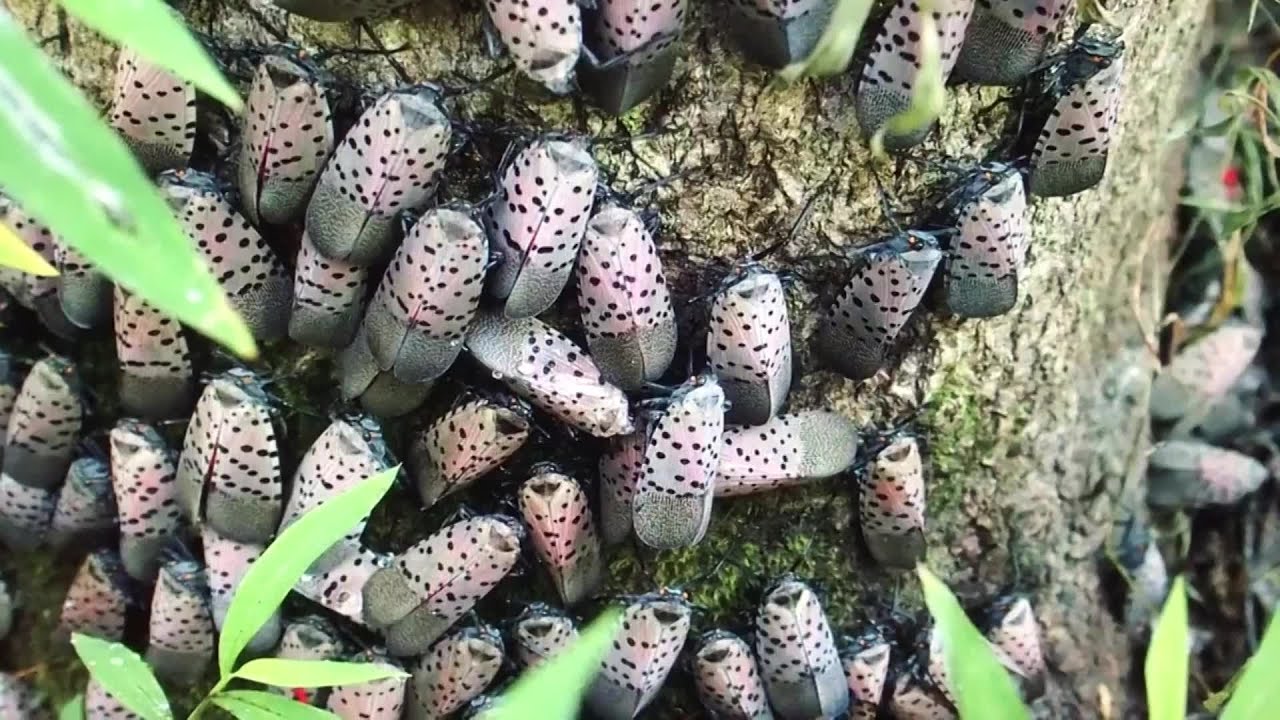By Vanessa Shehu, Staff Writer, and Anna Hsu, Staff Editor
Though Halloween has passed, a new menace continues to plague the campuses of Bryn Mawr and Haverford Colleges. At first glance, it looks like another harmless moth spotted with a playful polka-dot pattern. But upon closer inspection, its identifying features reveal its insidious nature. The tan, papery outer wings are splattered with midnight-black spots, which fade to a black-banded pattern reminiscent of fingerprint markings at the tips. Its six crooked gray legs, obscenely splayed, prop the hideous body up. When disturbed, it leaps away, fanning its inner wings in a gruesome flurry of blood-red, white, and black. At more than an inch long and half an inch wide, this colossus of the insect world stalks the streets of Pennsylvania. The eye, adjusted to the hideous sight, begins to see the insects crawling on every surface imaginable—tree trunks, light poles, walls, benches… nowhere is safe.
The spotted lantern fly is an invasive planthopper indigenous to South and East Asia, originating in China, Vietnam, and Bangladesh. According to the Pennsylvania Department of Agriculture, this invasive species was first spotted (no pun intended) in Pennsylvania in 2014, spreading to 14 other counties (including Philadelphia) which are now under quarantine.
Many students have shared their own horror stories regarding these repulsive arthropods. A legion of lantern flies can be found dead, alive, or somewhere in-between along the path to Erdman Dining Hall, turning stomachs and prompting shrieks of disgust. The crevices of the glass doors leading into Park Science Center can foster hosts of squirming lantern fly bodies. One student even recounted an instance where a lantern fly leapt off a seemingly-innocuous shirt she was examining at a nearby Target.
Anna and I had our first encounter with these scourges during a Saturday visit to Kung Fu Tea in Ardmore. While I’d hoped to recover from an excruciatingly hectic week with a refreshing matcha milk tea, my hopping nemesis had other plans. As I took my first sip, blissfully unaware of my plight, a quivering finger pointed at my head.
“It’s a bug, don’t move, don’t scream, it’s okay, it’s okay,” Anna rambled incoherently, taking a napkin and trying to coax the demon creature off my head while I stood frozen with terror.
The seconds stretched into minutes as I felt the entire store’s eyes planted on my skull. Panic overcame reason. I shook my head violently, flinging the bug off my head. It fell to the ground, stunned, but slowly began to crawl towards me once again like the horrific little girl from The Grudge. Shuddering, we made a quick retreat from the store, jumping in revulsion as we spotted scores of the creatures all across Ardmore on the way back.
Although these grotesque arthropods inspire revulsion and fear in many, they’re also a source of droll comic relief for Bi-Co meme culture. Posts touting the eradication of the flies, as well as comment threads filled with sympathy and encouragement for victims of these pests, have even prompted Bryn Mawr’s campus-wide meme group on Facebook to adopt the name “Bryn Mawr Memes for Lantern-Fly Crushing Teens.” Students have shared tips on how to kill the flies (such as “swat[ting] them with a jacket or hoodie” as a “medium range technique”), and have also shared a good laugh concerning odd fashion trends such as making lantern flies into earrings (“I gagged”, comments a student, while another remarks “I’m game if y’all are”). A meme of a man dressed as a lantern fly for Halloween went viral and was also shared on the page, with students appreciating the sloppily-taped “F*ck Yo Trees!” emblazoned on his chest. Another post featured an app dubbed Squishr, developed by a family from southeastern Pennsylvania, which helps users track and compete for the highest lantern fly kill score.
Though lighthearted, these memes accurately highlight the collective threat of the Spotted Lanternfly to Pennsylvania. These bugs can “serious[ly] damage” trees by causing “oozing sap,” “wilting,” “leaf curling,” and “tree dieback.” Additionally, their excretion (a sugary substance called “honeydew”) encourages the growth of black mold, which causes damage to plants. In the summer and spring, if we aren’t careful, swarms of lantern flies could “cover trees,” “swarm the air,” and “coat decks and play equipment” with sticky honeydew. Furthermore, the insects pose a huge threat to the agriculture industry by threatening the loss of “billions” of dollars and “hundreds of thousands of jobs for those in the grapes, apple, hops, and hardwood industries.” Compounded with the fact that these bugs have no natural predators in Pennsylvania, and are able to lay up to 50 eggs on any surface (including vehicles!), lantern flies have the potential to spread easily across the East Coast and wreak havoc on our lives if we don’t take action to stop them.
So what can we do to help to prevent the lantern fly apocalypse? As the Commonwealth of Pennsylvania aptly put it, “Kill it!” The bugs are at their egg-laying stage, and will coat any surface imaginable with goopy brown masses that resemble cracked mud. Not only should we do our civic duty by stomping on the adults, we should report sightings of adults or egg masses online or by calling 1-888-4BADFLY. And let your friends know about these invaders, so they can join the war effort against these vermin as well!
Sources and image credit: Pennsylvania Department of Agriculture




Just wanted to report that today (07/04/2020) while walking on Bryn Mawr’s campus and visiting the wild flower area and platform near Admissions, I killed as many young bugs as I could in the 10 minutes I was there. However, they were there in masses. Too many to address by just smooshing.